Approach
Patients with diabetic retinopathy usually have diabetes diagnosed before their retinopathy is identified. It is believed that diabetes may have been present for some time before retinopathy develops.
History
Clinicians should identify risk factors for incidence and progression of retinopathy, including:[62][70]
Duration and type of diabetes
Glycemic control
Hypertension
Dyslipidemia
Pregnancy
Renal disease
Cardiovascular disease
Previous laser, injection, or ocular surgery
Medication history
Most patients are asymptomatic or have symptoms unrelated to retinopathy, such as fluctuation in vision with blood glucose levels. Visual disturbances may occur later in disease (e.g., floaters due to vitreous hemorrhage). Symptomatic patients may have either gradual vision loss (caused by macular edema) or acute vision loss (caused by vitreous hemorrhage).
Clinical exam
Best corrected visual acuity should be measured. The anterior segment of the eye should be examined to exclude iris neovascularization and cataract. Intraocular pressure should be measured. The pupil should be dilated, following which the fundus and peripheral retina should be examined by stereoscopic biomicroscopy using Volk or similar lenses.[62][70]
Clinical signs of nonproliferative diabetic retinopathy (NPDR) include:[62][70]
Microaneurysms[Figure caption and citation for the preceding image starts]: Fluorescein angiogram of nonproliferative diabetic retinopathy: microaneurysms (red arrow), intraretinal microvascular abnormalities (blue arrow)Courtesy of Moorfields Photographic Archive; used with permission [Citation ends].
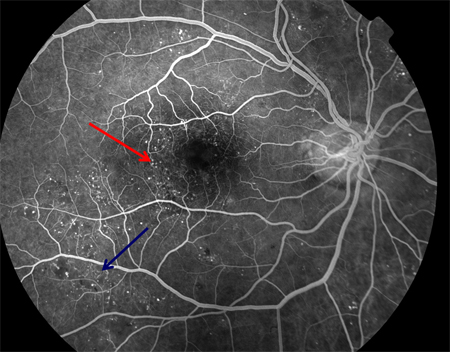
Cotton wool spots[Figure caption and citation for the preceding image starts]: Nonproliferative diabetic retinopathy: cluster hemorrhages (red circle), cotton wool spot (white arrow)Courtesy of Moorfields Photographic Archive; used with permission [Citation ends].
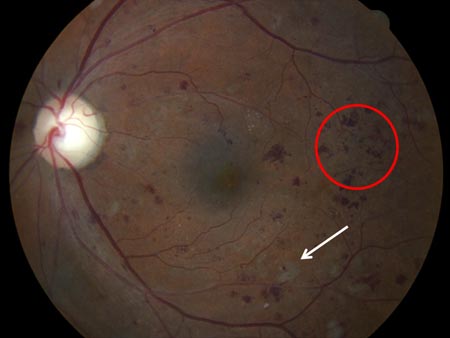 [Figure caption and citation for the preceding image starts]: Proliferative diabetic retinopathy: cotton wool spot (white arrow)Courtesy of Moorfields Photographic Archive; used with permission [Citation ends].
[Figure caption and citation for the preceding image starts]: Proliferative diabetic retinopathy: cotton wool spot (white arrow)Courtesy of Moorfields Photographic Archive; used with permission [Citation ends].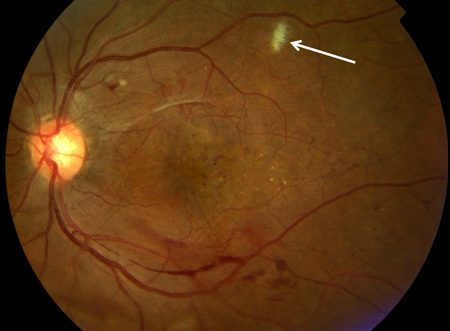
Intraretinal hemorrhage (presence of more than 20 in all 4 quadrants implies more severe retinopathy[Figure caption and citation for the preceding image starts]: Nonproliferative diabetic retinopathy: flame hemorrhage (red arrow), venous beading (white rectangle)Courtesy of Moorfields Photographic Archive; used with permission [Citation ends].
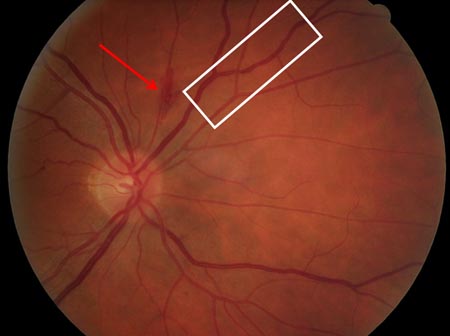 [Figure caption and citation for the preceding image starts]: Nonproliferative diabetic retinopathy with macular edema: exudate plaque (yellow arrow), cluster hemorrhage (green arrow), venous beading (blue arrow)Courtesy of Moorfields Photographic Archive; used with permission [Citation ends].
[Figure caption and citation for the preceding image starts]: Nonproliferative diabetic retinopathy with macular edema: exudate plaque (yellow arrow), cluster hemorrhage (green arrow), venous beading (blue arrow)Courtesy of Moorfields Photographic Archive; used with permission [Citation ends].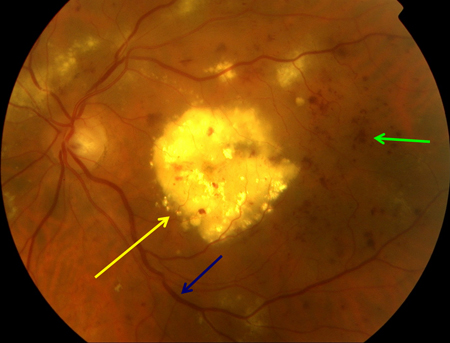 [Figure caption and citation for the preceding image starts]: Nonproliferative diabetic retinopathy: blot hemorrhage (white circle)Courtesy of Moorfields Photographic Archive; used with permission [Citation ends].
[Figure caption and citation for the preceding image starts]: Nonproliferative diabetic retinopathy: blot hemorrhage (white circle)Courtesy of Moorfields Photographic Archive; used with permission [Citation ends].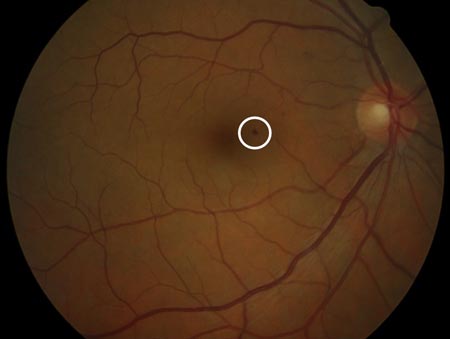
Venous beading (presence in 2 or more quadrants indicates more severe retinopathy)[Figure caption and citation for the preceding image starts]: Nonproliferative diabetic retinopathy with macular edema: exudate (yellow arrow), microaneurysms (red arrow), venous dilatation (blue arrow), cotton wool spot (white arrow)Courtesy of Moorfields Photographic Archive; used with permission [Citation ends].
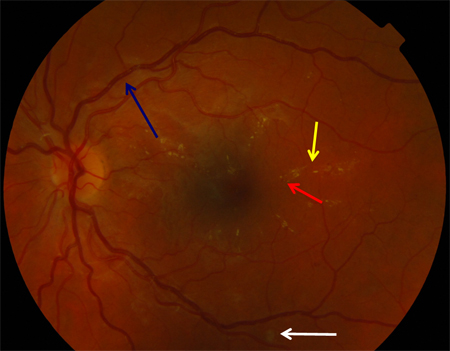 [Figure caption and citation for the preceding image starts]: Nonproliferative diabetic retinopathy with macular edema: exudate plaque (yellow arrow), cluster hemorrhage (green arrow), venous beading (blue arrow)Courtesy of Moorfields Photographic Archive; used with permission [Citation ends].
[Figure caption and citation for the preceding image starts]: Nonproliferative diabetic retinopathy with macular edema: exudate plaque (yellow arrow), cluster hemorrhage (green arrow), venous beading (blue arrow)Courtesy of Moorfields Photographic Archive; used with permission [Citation ends]. [Figure caption and citation for the preceding image starts]: Nonproliferative diabetic retinopathy: intraretinal microvascular abnormality (IRMA; green arrow), venous beading and segmentation (blue arrow), cluster hemorrhage (red circle), featureless retina suggestive of capillary nonperfusion (white ellipse)Courtesy of Moorfields Photographic Archive; used with permission [Citation ends].
[Figure caption and citation for the preceding image starts]: Nonproliferative diabetic retinopathy: intraretinal microvascular abnormality (IRMA; green arrow), venous beading and segmentation (blue arrow), cluster hemorrhage (red circle), featureless retina suggestive of capillary nonperfusion (white ellipse)Courtesy of Moorfields Photographic Archive; used with permission [Citation ends]. [Figure caption and citation for the preceding image starts]: Proliferative diabetic retinopathy: retrohyaloid hemorrhage (red arrow)Courtesy of Moorfields Photographic Archive; used with permission [Citation ends].
[Figure caption and citation for the preceding image starts]: Proliferative diabetic retinopathy: retrohyaloid hemorrhage (red arrow)Courtesy of Moorfields Photographic Archive; used with permission [Citation ends].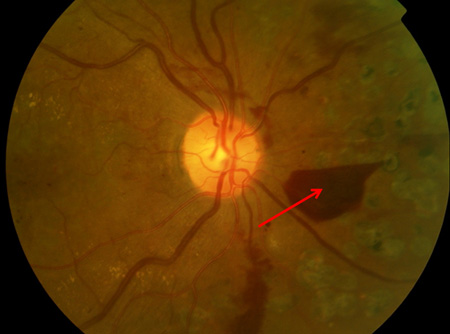
Intraretinal microvascular abnormalities (presence of any intraretinal microvascular abnormalities indicates more severe retinopathy).[Figure caption and citation for the preceding image starts]: Proliferative diabetic retinopathy: optic disk new vessels (red arrow), intraretinal microvascular abnormality (IRMA; green arrow), cotton wool spot (white arrow), venous beading and segmentation (red rectangle), featureless retina suggestive of capillary nonperfusion (white ellipse)Courtesy of Moorfields Photographic Archive; used with permission [Citation ends].
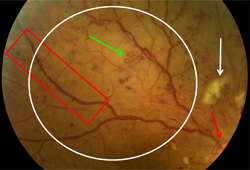 [Figure caption and citation for the preceding image starts]: Nonproliferative diabetic retinopathy: intraretinal microvascular abnormality (IRMA; green arrow), venous beading and segmentation (blue arrow), cluster hemorrhage (red circle), featureless retina suggestive of capillary nonperfusion (white ellipse)Courtesy of Moorfields Photographic Archive; used with permission [Citation ends].
[Figure caption and citation for the preceding image starts]: Nonproliferative diabetic retinopathy: intraretinal microvascular abnormality (IRMA; green arrow), venous beading and segmentation (blue arrow), cluster hemorrhage (red circle), featureless retina suggestive of capillary nonperfusion (white ellipse)Courtesy of Moorfields Photographic Archive; used with permission [Citation ends].
The 4-2-1 rule for severe nonproliferative diabetic retinopathy states:
4: more than 20 intraretinal hemorrhages in 4 quadrants
2: venous beading in 2 or more quadrants
1: intraretinal microvascular abnormalities in 1 or more quadrants.
Nonproliferative retinopathy may progress to proliferative diabetic retinopathy (PDR) characterized by:
Optic disk neovascularization[Figure caption and citation for the preceding image starts]: Proliferative diabetic retinopathy: new vessels on the optic disk (red circle)Courtesy of Moorfields Photographic Archive; used with permission [Citation ends].
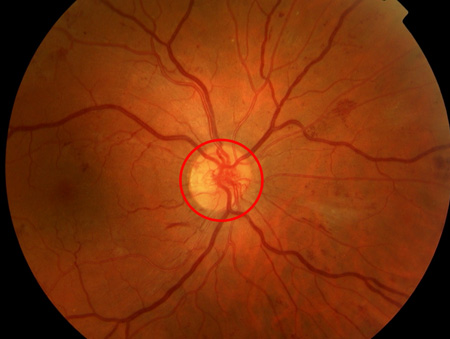 [Figure caption and citation for the preceding image starts]: Proliferative diabetic retinopathy: new vessels on the optic disk (red circle), retrohyaloid hemorrhage (red arrow), new vessels elsewhere with fibrosis (white arrow), dot and blot hemorrhage (green arrow)Courtesy of Moorfields Photographic Archive; used with permission [Citation ends].
[Figure caption and citation for the preceding image starts]: Proliferative diabetic retinopathy: new vessels on the optic disk (red circle), retrohyaloid hemorrhage (red arrow), new vessels elsewhere with fibrosis (white arrow), dot and blot hemorrhage (green arrow)Courtesy of Moorfields Photographic Archive; used with permission [Citation ends].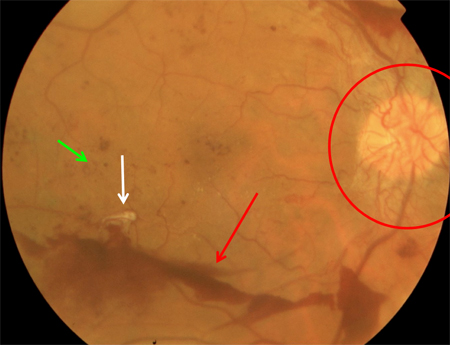 [Figure caption and citation for the preceding image starts]: Proliferative diabetic retinopathy: macular laser burns (black arrow), misty vitreous hemorrhage (blue arrow), clot within vitreous hemorrhage (red arrow)Courtesy of Moorfields Photographic Archive; used with permission [Citation ends].
[Figure caption and citation for the preceding image starts]: Proliferative diabetic retinopathy: macular laser burns (black arrow), misty vitreous hemorrhage (blue arrow), clot within vitreous hemorrhage (red arrow)Courtesy of Moorfields Photographic Archive; used with permission [Citation ends].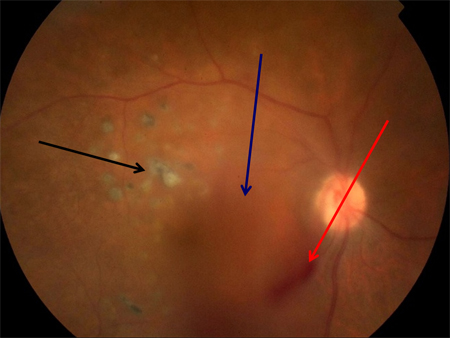 [Figure caption and citation for the preceding image starts]: Proliferative diabetic retinopathy: optic disk new vessels (red arrow), intraretinal microvascular abnormality (IRMA; green arrow), cotton wool spot (white arrow), venous beading and segmentation (red rectangle), featureless retina suggestive of capillary nonperfusion (white ellipse)Courtesy of Moorfields Photographic Archive; used with permission [Citation ends].
[Figure caption and citation for the preceding image starts]: Proliferative diabetic retinopathy: optic disk new vessels (red arrow), intraretinal microvascular abnormality (IRMA; green arrow), cotton wool spot (white arrow), venous beading and segmentation (red rectangle), featureless retina suggestive of capillary nonperfusion (white ellipse)Courtesy of Moorfields Photographic Archive; used with permission [Citation ends]. [Figure caption and citation for the preceding image starts]: Proliferative diabetic retinopathy: retrohyaloid hemorrhage (red arrow)Courtesy of Moorfields Photographic Archive; used with permission [Citation ends].
[Figure caption and citation for the preceding image starts]: Proliferative diabetic retinopathy: retrohyaloid hemorrhage (red arrow)Courtesy of Moorfields Photographic Archive; used with permission [Citation ends].
Retinal neovascularization [Figure caption and citation for the preceding image starts]: Proliferative diabetic retinopathy: new vessels on the optic disk (red circle)Courtesy of Moorfields Photographic Archive; used with permission [Citation ends].
 [Figure caption and citation for the preceding image starts]: Proliferative diabetic retinopathy: new vessels elsewhere (red arrow), venous beading (blue arrow), intraretinal microvascular abnormality (green arrow)Courtesy of Moorfields Photographic Archive; used with permission [Citation ends].
[Figure caption and citation for the preceding image starts]: Proliferative diabetic retinopathy: new vessels elsewhere (red arrow), venous beading (blue arrow), intraretinal microvascular abnormality (green arrow)Courtesy of Moorfields Photographic Archive; used with permission [Citation ends].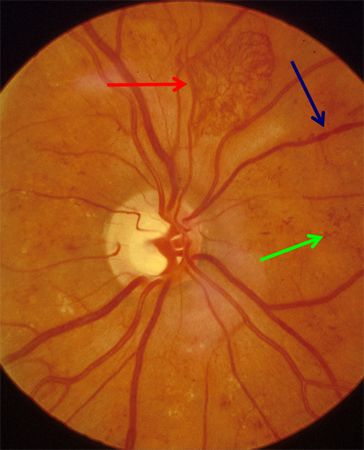 [Figure caption and citation for the preceding image starts]: Proliferative diabetic retinopathy: retrohyaloid hemorrhage (red arrow), venous beading (blue arrow), cluster hemorrhage (white circle), panretinal laser burns (black arrow)Courtesy of Moorfields Photographic Archive; used with permission [Citation ends].
[Figure caption and citation for the preceding image starts]: Proliferative diabetic retinopathy: retrohyaloid hemorrhage (red arrow), venous beading (blue arrow), cluster hemorrhage (white circle), panretinal laser burns (black arrow)Courtesy of Moorfields Photographic Archive; used with permission [Citation ends].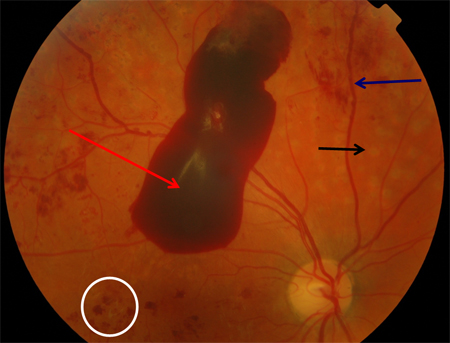 [Figure caption and citation for the preceding image starts]: Proliferative diabetic retinopathy: traction toward optic disk and consequent total retinal detachment (white block arrow)Courtesy of Moorfields Photographic Archive; used with permission [Citation ends].
[Figure caption and citation for the preceding image starts]: Proliferative diabetic retinopathy: traction toward optic disk and consequent total retinal detachment (white block arrow)Courtesy of Moorfields Photographic Archive; used with permission [Citation ends].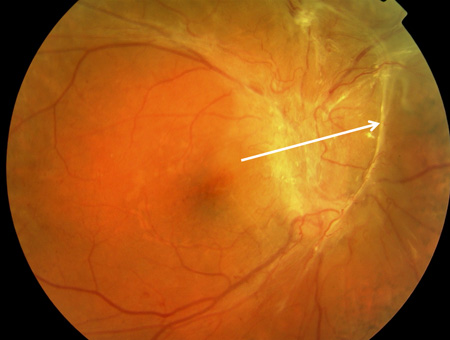
Preretinal or vitreous hemorrhage [Figure caption and citation for the preceding image starts]: Proliferative diabetic retinopathy: nerve fiber layer hemorrhage (yellow arrow)Courtesy of Moorfields Photographic Archive; used with permission [Citation ends].
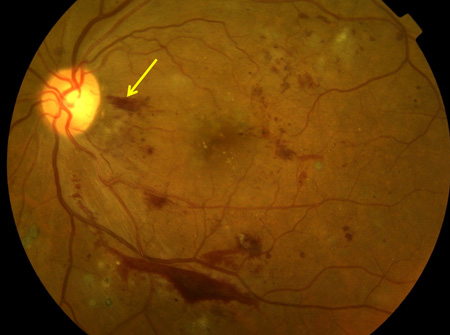 [Figure caption and citation for the preceding image starts]: Proliferative diabetic retinopathy: venous beading (blue arrow)Courtesy of Moorfields Photographic Archive; used with permission [Citation ends].
[Figure caption and citation for the preceding image starts]: Proliferative diabetic retinopathy: venous beading (blue arrow)Courtesy of Moorfields Photographic Archive; used with permission [Citation ends].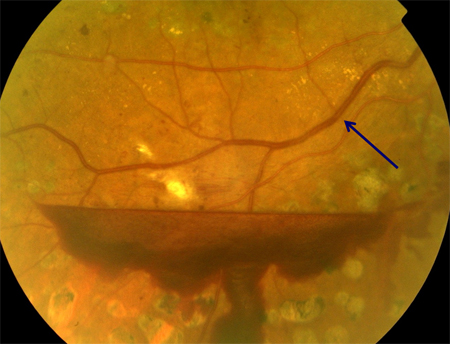 [Figure caption and citation for the preceding image starts]: Proliferative diabetic retinopathy: extensive vitreous hemorrhage obscuring most of fundus (white circle)Courtesy of Moorfields Photographic Archive; used with permission [Citation ends].
[Figure caption and citation for the preceding image starts]: Proliferative diabetic retinopathy: extensive vitreous hemorrhage obscuring most of fundus (white circle)Courtesy of Moorfields Photographic Archive; used with permission [Citation ends]. [Figure caption and citation for the preceding image starts]: Proliferative diabetic retinopathy: retrohyaloid hemorrhage (red arrow), venous beading (blue arrow), cluster hemorrhage (white circle), panretinal laser burns (black arrow)Courtesy of Moorfields Photographic Archive; used with permission [Citation ends].
[Figure caption and citation for the preceding image starts]: Proliferative diabetic retinopathy: retrohyaloid hemorrhage (red arrow), venous beading (blue arrow), cluster hemorrhage (white circle), panretinal laser burns (black arrow)Courtesy of Moorfields Photographic Archive; used with permission [Citation ends]. [Figure caption and citation for the preceding image starts]: Proliferative diabetic retinopathy: new vessels elsewhere (white arrow), vitreous (intra-gel) hemorrhage (green arrow), retrohyaloid hemorrhage (red arrow)Courtesy of Moorfields Photographic Archive; used with permission [Citation ends].
[Figure caption and citation for the preceding image starts]: Proliferative diabetic retinopathy: new vessels elsewhere (white arrow), vitreous (intra-gel) hemorrhage (green arrow), retrohyaloid hemorrhage (red arrow)Courtesy of Moorfields Photographic Archive; used with permission [Citation ends].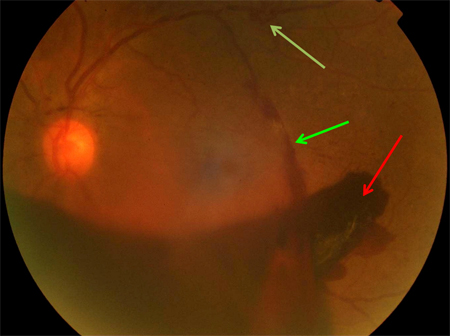
Retinal detachment. [Figure caption and citation for the preceding image starts]: Proliferative diabetic retinopathy: traction toward optic disk and consequent total retinal detachment (white block arrow)Courtesy of Moorfields Photographic Archive; used with permission [Citation ends].
 [Figure caption and citation for the preceding image starts]: Proliferative diabetic retinopathy: traction tear (white ellipse)Courtesy of Moorfields Photographic Archive; used with permission [Citation ends].
[Figure caption and citation for the preceding image starts]: Proliferative diabetic retinopathy: traction tear (white ellipse)Courtesy of Moorfields Photographic Archive; used with permission [Citation ends].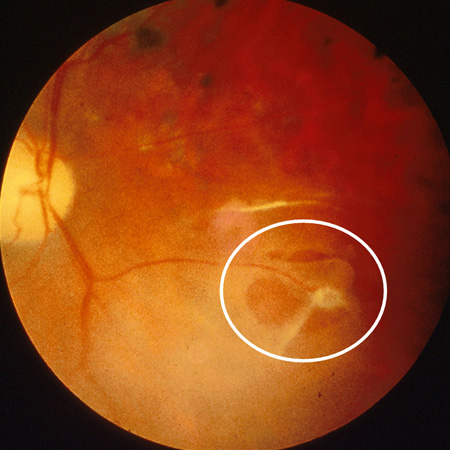
Eyes with untreated or inadequately treated proliferative retinopathy may progress to severe proliferative diabetic retinopathy with features such as traction retinal detachment and traction-rhegmatogenous retinal detachment.
Intraretinal edema may involve the central retina, causing macular edema, which appears as elevation or thickening of the central macula on stereoscopic evaluation. Macular edema may occur in NPDR or PDR.[Figure caption and citation for the preceding image starts]: Nonproliferative diabetic retinopathy with macular edema: exudate (yellow arrow), microaneurysms (red arrow), thickened retina (white circle), cystic change at macula (blue arrow)Courtesy of Moorfields Photographic Archive; used with permission [Citation ends]. [Figure caption and citation for the preceding image starts]: Nonproliferative diabetic retinopathy with macular edema: cotton wool spot (white arrow), thickened retina (white circle)Courtesy of Moorfields Photographic Archive; used with permission [Citation ends].
[Figure caption and citation for the preceding image starts]: Nonproliferative diabetic retinopathy with macular edema: cotton wool spot (white arrow), thickened retina (white circle)Courtesy of Moorfields Photographic Archive; used with permission [Citation ends]. [Figure caption and citation for the preceding image starts]: Optical coherence tomography in macular edema: loss of central foveal depression (yellow arrow), accumulation of fluid within cystoid spaces at fovea (red arrow)Courtesy of Moorfields Photographic Archive; used with permission [Citation ends].
[Figure caption and citation for the preceding image starts]: Optical coherence tomography in macular edema: loss of central foveal depression (yellow arrow), accumulation of fluid within cystoid spaces at fovea (red arrow)Courtesy of Moorfields Photographic Archive; used with permission [Citation ends].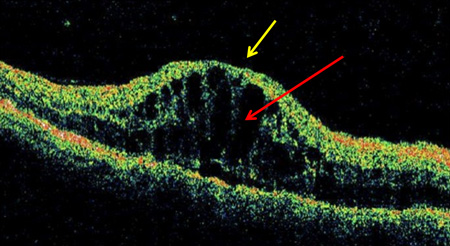 Both lipid exudates and/or microaneurysms may also indicate macular edema.[Figure caption and citation for the preceding image starts]: Nonproliferative diabetic retinopathy with macular edema: thickened retina (white ellipse), exudate (yellow arrow)Courtesy of Moorfields Photographic Archive; used with permission [Citation ends].
Both lipid exudates and/or microaneurysms may also indicate macular edema.[Figure caption and citation for the preceding image starts]: Nonproliferative diabetic retinopathy with macular edema: thickened retina (white ellipse), exudate (yellow arrow)Courtesy of Moorfields Photographic Archive; used with permission [Citation ends].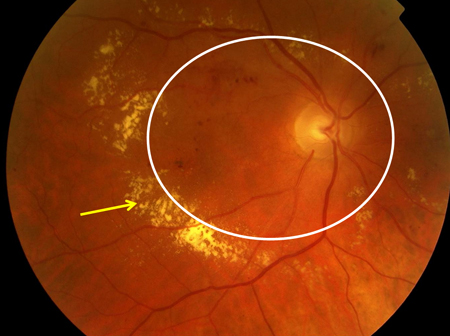
None of these signs is diagnostic for diabetic retinopathy, and all may occur in other conditions. However, diffuse bilateral posterior pole involvement with such signs in a patient with diabetes usually suggests diabetic retinopathy.
Ancillary tests
Other tests that may be used to confirm diagnosis include:[62][70]
Optical coherence tomography: should be ordered for all patients at baseline; for patients with exudation, hemorrhages, or microaneurysms in the macular area; and for patients with unexplained visual loss.[Figure caption and citation for the preceding image starts]: Optical coherence tomography in macular edema: loss of central foveal depression (yellow arrow), accumulation of fluid within cystoid spaces at fovea (red arrow)Courtesy of Moorfields Photographic Archive; used with permission [Citation ends].
 [Figure caption and citation for the preceding image starts]: Optical coherence tomogram of normal eye: normal foveal depression at center of macula (yellow arrow), inner retina (toward center of eye; red arrow), outer retina (farther from center of eye; blue arrow)Courtesy of Moorfields Photographic Archive; used with permission [Citation ends].
[Figure caption and citation for the preceding image starts]: Optical coherence tomogram of normal eye: normal foveal depression at center of macula (yellow arrow), inner retina (toward center of eye; red arrow), outer retina (farther from center of eye; blue arrow)Courtesy of Moorfields Photographic Archive; used with permission [Citation ends]. [Figure caption and citation for the preceding image starts]: Optical coherence tomography in vitreomacular traction: loss of foveal depression with traction on fovea (in direction of yellow arrow)Courtesy of Moorfields Photographic Archive; used with permission [Citation ends].
[Figure caption and citation for the preceding image starts]: Optical coherence tomography in vitreomacular traction: loss of foveal depression with traction on fovea (in direction of yellow arrow)Courtesy of Moorfields Photographic Archive; used with permission [Citation ends].
Digital photographs of the fundus: these should be ordered at baseline evaluation and when significant change is perceived in the fundus findings.[Figure caption and citation for the preceding image starts]: Normal retina left eye: optic disk (white square), macula (white circle), arteriole (red arrow), venule (blue arrow)Courtesy of Moorfields Photographic Archive; used with permission [Citation ends].

Fluorescein angiography: this is indicated in some patients with diabetic maculopathy, and some patients with severe nonproliferative/proliferative retinopathy.[16][Figure caption and citation for the preceding image starts]: Fluorescein angiogram in mid-venous phase in diabetic retinopathy with microaneurysms only: microaneurysm (red arrow), optic disk (yellow arrow), macula (white circle)Courtesy of Moorfields Photographic Archive; used with permission [Citation ends].
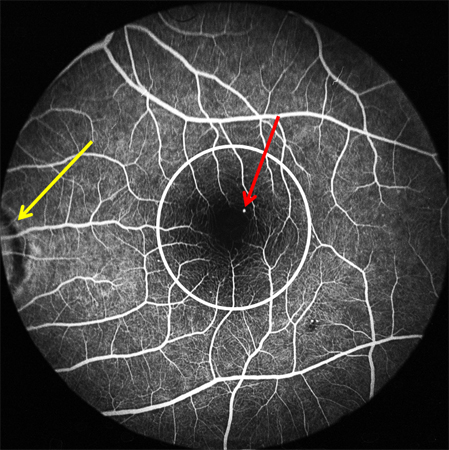 [Figure caption and citation for the preceding image starts]: Fluorescein angiogram of nonproliferative diabetic retinopathy: microaneurysms (red arrow), intraretinal microvascular abnormalities (blue arrow)Courtesy of Moorfields Photographic Archive; used with permission [Citation ends].
[Figure caption and citation for the preceding image starts]: Fluorescein angiogram of nonproliferative diabetic retinopathy: microaneurysms (red arrow), intraretinal microvascular abnormalities (blue arrow)Courtesy of Moorfields Photographic Archive; used with permission [Citation ends]. [Figure caption and citation for the preceding image starts]: Fluorescein angiogram in proliferative diabetic retinopathy with macular ischemia: macular ischemia (green circle), capillary nonperfusion (white arrow), optic disk new vessels (red arrow), venous beading (blue arrow)Courtesy of Moorfields Photographic Archive; used with permission [Citation ends].
[Figure caption and citation for the preceding image starts]: Fluorescein angiogram in proliferative diabetic retinopathy with macular ischemia: macular ischemia (green circle), capillary nonperfusion (white arrow), optic disk new vessels (red arrow), venous beading (blue arrow)Courtesy of Moorfields Photographic Archive; used with permission [Citation ends].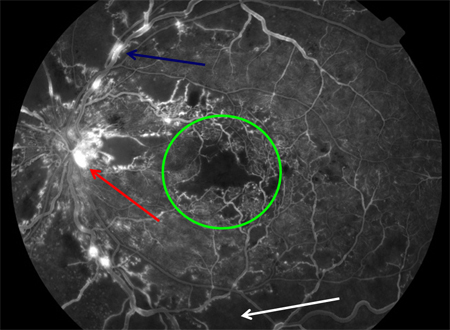
[Figure caption and citation for the preceding image starts]: Fluorescein angiography in proliferative diabetic retinopathy. Vascular component of fibrovascular proliferation (red arrows), capillary nonperfusion (yellow arrow), laser burns (green circle)Courtesy of Moorfields Photographic Archive; used with permission [Citation ends].
 [Figure caption and citation for the preceding image starts]: Fluorescein angiogram in proliferative diabetic retinopathy: new vessels on the optic disk (red arrow), capillary nonperfusion (red rectangle), microaneurysms (green circle), venous beading (blue arrow), intraretinal microvascular abnormalities (yellow arrow)Courtesy of Moorfields Photographic Archive; used with permission [Citation ends].
[Figure caption and citation for the preceding image starts]: Fluorescein angiogram in proliferative diabetic retinopathy: new vessels on the optic disk (red arrow), capillary nonperfusion (red rectangle), microaneurysms (green circle), venous beading (blue arrow), intraretinal microvascular abnormalities (yellow arrow)Courtesy of Moorfields Photographic Archive; used with permission [Citation ends].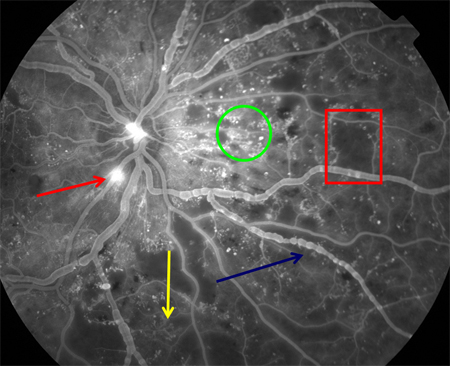 [Figure caption and citation for the preceding image starts]: Fluorescein angiogram in proliferative diabetic retinopathy: new vessels elsewhere (red circle), capillary nonperfusion (white arrow), panretinal laser burns (blue arrow)Courtesy of Moorfields Photographic Archive; used with permission [Citation ends].
[Figure caption and citation for the preceding image starts]: Fluorescein angiogram in proliferative diabetic retinopathy: new vessels elsewhere (red circle), capillary nonperfusion (white arrow), panretinal laser burns (blue arrow)Courtesy of Moorfields Photographic Archive; used with permission [Citation ends].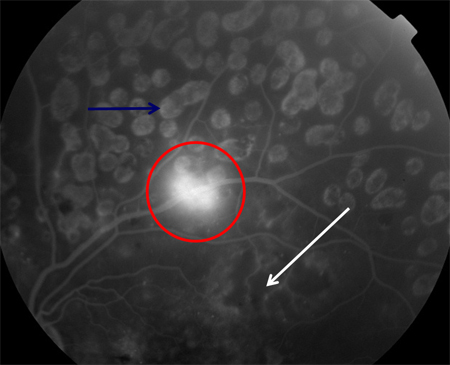
Optical coherence tomography angiography: this may be helpful in diagnosing macular ischemia.[71][Figure caption and citation for the preceding image starts]: Optical coherence tomography in macular edema: loss of central foveal depression (yellow arrow), accumulation of fluid within cystoid spaces at fovea (red arrow)Courtesy of Moorfields Photographic Archive; used with permission [Citation ends].
 [Figure caption and citation for the preceding image starts]: Optical coherence tomogram of normal eye: normal foveal depression at center of macula (yellow arrow), inner retina (toward center of eye; red arrow), outer retina (farther from center of eye; blue arrow)Courtesy of Moorfields Photographic Archive; used with permission [Citation ends].
[Figure caption and citation for the preceding image starts]: Optical coherence tomogram of normal eye: normal foveal depression at center of macula (yellow arrow), inner retina (toward center of eye; red arrow), outer retina (farther from center of eye; blue arrow)Courtesy of Moorfields Photographic Archive; used with permission [Citation ends]. [Figure caption and citation for the preceding image starts]: Optical coherence tomography in vitreomacular traction: loss of foveal depression with traction on fovea (in direction of yellow arrow)Courtesy of Moorfields Photographic Archive; used with permission [Citation ends].
[Figure caption and citation for the preceding image starts]: Optical coherence tomography in vitreomacular traction: loss of foveal depression with traction on fovea (in direction of yellow arrow)Courtesy of Moorfields Photographic Archive; used with permission [Citation ends].
B-scan ultrasonography: this should be ordered in patients in whom media opacity (e.g., vitreous hemorrhage), prevents visualization of the fundus.
Defining the severity of retinopathy and macular edema
Using the retinal findings above and optical coherence tomography, the clinician can determine retinopathy severity and the presence or absence of macular edema, and define the combined severity using the scales detailed in the Classification section under Etiology.
Use of this content is subject to our disclaimer